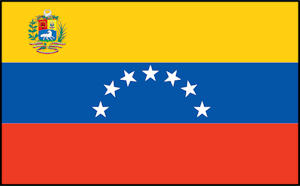Venezuela Flag Facts
-
Interesting Facts for Kids 1: Venezuela Flag
The flag of Venezuela was initially created by the military leader and revolutionary, Francisco de Miranda, in 1806 as he launched the first expedition to free Venezuela. His expedition was unsuccessful but his initial tricolor flag design inspired various other countries of South America. -
Interesting Facts for Kids 2: Venezuela Flag
The flag designed by Francisco de Miranda featured three horizontal bars using the tricolors of yellow, blue and red. The color yellow stood for the wealth of the land, blue for the courage of its people, and red for their independence from Spain. -
Interesting Facts for Kids 3: Venezuela Flag
The basic tricolor design was adopted in 1811, the year following the outbreak of the Venezuelan War of Independence that occurred from 1810 to 1823. Venezuela was declared an independent country in 1821 but the war continued until 1823 when independence from Spain was achieved. -
Interesting Facts for Kids 4: Venezuela Flag Day
Flag Day is commemorated on 3 August in Venezuela. This date marks the first raising of the flag by its designer, Francisco de Miranda in 1806. -
Interesting Facts for Kids 5: Venezuela Flag
The government introduced a new flag in 1861 that used the same basic tricolor design but also featured seven white stars in a hexagon shape at the centre of the horizontal blue stripe. Under the presidency of Hugo Chavez, the flag later received some alterations which included the addition of an 8th star to the crescent of stars central to the flag’s design. -
Interesting Facts for Kids 6: The coat of arms of Venezuela
During the mid 1900’s, the flag received an additional feature when the coat of arms of Venezuela was added to the upper hoist canton. The previous flag became a civil flag and the updated one became the new State flag. -
Interesting Facts for Kids 7: The coat of arms of Venezuela
The coat of arms of Venezuela features a shield divided into three areas, each bearing one of the tricolors of the country’s national flag. The upper left section of the shield is red and features a golden wheat sheaf comprising twenty ears; one for each state in the Republic. The upper right section of the shield is yellow and features weapons and two national flags tied with laurel to represent victory and triumph of Venezuela. The bottom section of the shield is blue and features a white running horse. Two Horns of Plenty form part of the coat of arms and are positioned above the shield, as are two branches; one olive and the other palm. They are bound together by a ribbon in the national colors -
Interesting Facts for Kids 8: The Venezuelan Coat of Arms Horse Meaning
The horse is representative of Venezuela’s freedom and independence. The original coat of arms design saw the horse running right with its head turned, looking towards the left. The new design, which was introduced under the presidency of Hugo Chavez, depicts the horse running left with its head positioned in the same direction. Some controversy has emerged over this alteration to the coat of arms of Venezuela as some say the horse runs and looks the same way, towards independence and freedom. However, some critics argue that the horse runs left, in line with Hugo Chavez’s stated political views.
